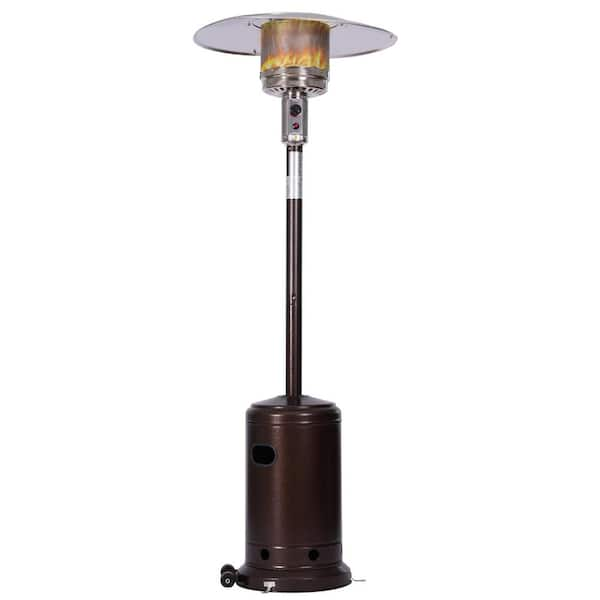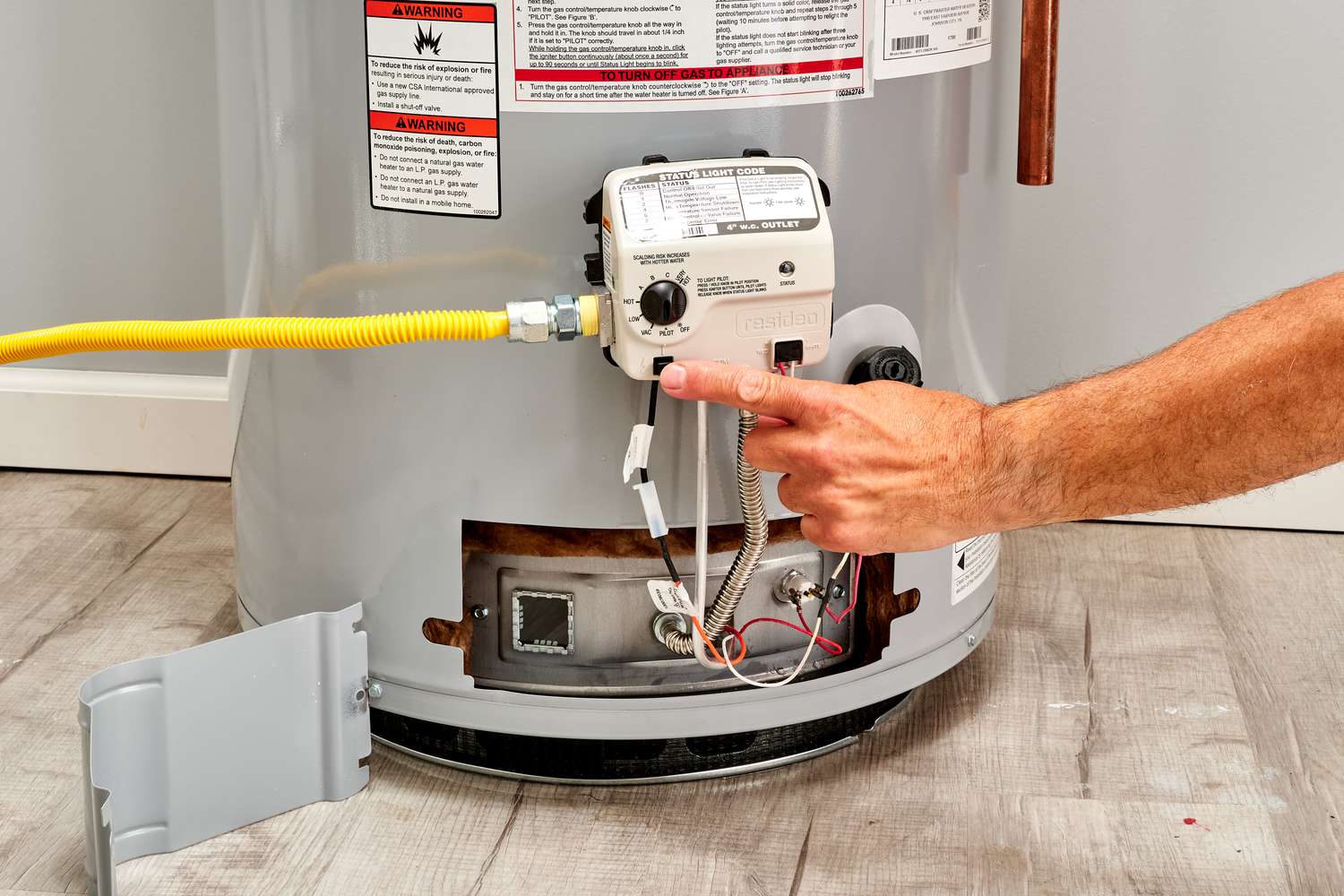Patio heater igniters do not usually have batteries. These devices typically use a piezo igniter, which generates a spark through mechanical action.
In outdoor spaces, patio heaters are a popular choice for keeping warm during cooler seasons. These heaters often come with a built-in ignition system, known as an igniter, that is responsible for starting the flame. One common type of igniter used in patio heaters is the piezo igniter.
This mechanism does not rely on batteries to function. Instead, it employs mechanical action to generate a spark, which then lights the fuel and creates the desired radiant heat. Without the need for batteries, patio heaters with piezo igniters provide convenience and ease of use, making them a practical option for outdoor heating solutions.

Credit: www.homedepot.com
The Basics Of Patio Heater Ignition Systems
Patio heater ignition systems are typically battery-powered, providing hassle-free starting functionality. With no need for external power sources, these convenient igniters allow for easy ignition and enjoyment of your patio heater.
If you’re wondering how patio heater igniters work and whether or not they have batteries, you’ve come to the right place. In this section, we’ll delve into the basics of patio heater ignition systems, including the common types, how they work, and the components involved in starting the heater.
Common Types Of Ignition Systems For Outdoor Patio Heaters:
- Piezo ignition system: This type of ignition system uses a button or push-down lever to generate a spark that ignites the gas. It does not require batteries and is commonly found in many patio heaters.
- Electronic ignition system: Unlike piezo ignition, electronic ignition systems require batteries. They use an electronic spark generator to create a spark and start the heater. These systems are often found in more advanced or high-end patio heaters.
How They Work And The Role They Play In Starting The Heater:
- Piezo ignition system: When the button or lever is pressed, it pushes a tiny lever inside the igniter, which generates a high voltage electric spark. This spark ignites the gas in the heater, resulting in a flame that warms the patio area.
- Electronic ignition system: The electronic ignition system uses a battery-powered spark generator to create an electric spark that ignites the gas. The battery provides the necessary power for the system to function. Once the gas is ignited, the heater starts to produce heat, warming the surrounding area.
Exploring The Different Components Involved In Ignition Systems:
- Piezo ignition system:
- Igniter button or lever: This is the part that you press in order to generate a spark.
- Igniter mechanism: Inside the igniter, there is a small lever that, when pressed, creates a spark by striking against a piece of quartz or metal.
- Electronic ignition system:
- Battery: The battery provides the power needed to generate the spark in the ignition system.
- Spark generator: This component creates an electric spark by sending a high voltage current to a spark electrode, which then ignites the gas.
Having a good understanding of the common types of ignition systems for patio heaters, how they work, and the components involved, can help you choose the right patio heater for your needs. Whether you opt for a piezo ignition system or an electronic ignition system, both offer efficient and reliable ways to start your patio heater and enjoy the warmth it provides.
Understanding The Role Of Batteries In Patio Heater Igniters
Patio heater igniters do not typically have batteries because they rely on other fuel sources, such as propane or natural gas, to initiate the ignition process. Understanding the role of batteries in patio heater igniters is important for maintenance and troubleshooting purposes.
When it comes to patio heater igniters, batteries play a crucial role in ensuring that your outdoor space stays warm and cozy. In this section, we will delve into the importance of batteries in ignition systems, how they provide the necessary power for ignition, and explore the different types of batteries used in patio heater igniters.
Importance Of Batteries In Ignition Systems:
- Reliable ignition: Batteries are vital for ensuring a reliable ignition process in patio heaters. They provide the necessary electrical power to ignite the fuel and start the heating process.
- Convenient operation: With batteries powering the ignition system, patio heaters become more convenient to use. You no longer need to rely on external power sources or cords, giving you the freedom to position your heater wherever you desire.
- Portable design: Having batteries in patio heater igniters allows for a portable design. You can easily move your heater around your outdoor space without the limitations of being near a power outlet.
- Backup power: In case of power outages or situations where an electrical power supply isn’t available, batteries act as a backup power source for igniting the patio heater. This ensures that you can still enjoy the warmth of your outdoor area during such instances.
How Batteries Provide The Power Necessary For Ignition:
- Electrical energy conversion: Batteries convert stored chemical energy into electrical energy, which powers the ignition system of patio heaters. This energy is then used to create an electric spark that ignites the fuel and initiates the heating process.
- Low voltage requirements: Patio heater igniters typically operate on low voltage requirements, making batteries an ideal power source. They can deliver the needed voltage to produce the spark while maintaining safety and efficiency.
Exploring The Different Types Of Batteries Used In Patio Heater Igniters:
- Alkaline batteries: Alkaline batteries, such as aa or aaa batteries, are commonly used in patio heater igniters due to their availability and cost-effectiveness. They provide a reliable power source and have a decent lifespan.
- Lithium-ion batteries: Lithium-ion batteries offer a longer lifespan compared to alkaline batteries. They can sustain higher current draws, making them suitable for patio heater igniters that require more power. However, they can be slightly more expensive.
- Rechargeable batteries: Rechargeable batteries, like nimh or li-ion rechargeable batteries, provide a sustainable alternative to disposable batteries. They can be reused multiple times, reducing waste and saving money in the long run.
Remember, choosing the right type of battery for your patio heater igniter depends on factors such as desired power output, longevity, and personal preference.
Next, we will discuss the importance of regular maintenance to ensure optimal performance and longevity of your patio heater igniter. Stay tuned!
Pros And Cons Of Battery-Powered Ignition Systems
Battery-powered ignition systems for patio heaters have their pros and cons. On the positive side, they offer convenience, mobility, and ease of use. However, they may require battery replacements and can be less reliable in extreme weather conditions.
Battery-powered ignition systems offer several advantages over traditional ignition systems that require electrical power sources. However, they also come with their own set of drawbacks. Let’s explore the pros and cons of using battery-powered igniters:
Advantages Of Using Battery-Powered Igniters:
- Portability and ease of use: Battery-powered igniters offer the convenience of being portable and easy to move around. With no need for electrical wiring or outlets, you can place your patio heater anywhere you desire.
- Lower maintenance requirements: Unlike electrical igniters that may require regular inspection and repairs, battery-powered igniters have minimal maintenance needs. Simply replace the batteries when they run out of power.
- Reliable ignition even during power outages: Battery-powered igniters ensure that you can still enjoy the warmth of your patio heater during power outages. This feature can be especially useful during inclement weather or when camping outdoors.
Disadvantages Of Battery-Powered Igniters:
- Limited lifespan of batteries: Batteries eventually lose their charge capacity over time. This means that you will need to replace them periodically to ensure that your ignition system continues to work effectively.
- Potential for battery leakage or corrosion: The internal components of batteries can sometimes leak or corrode, leading to malfunctioning igniters. Regularly inspecting the batteries and promptly replacing them can prevent this issue.
Battery-powered igniters offer portability, ease of use, lower maintenance needs, and reliable ignition during power outages. However, they do have limitations, such as the need for battery replacements due to their limited lifespan and the potential for battery leakage or corrosion.
Consider these pros and cons when deciding whether a battery-powered igniter is the right choice for your patio heater.
Exploring Alternatives To Battery-Powered Igniters
Patio heater igniters do not typically require batteries, as they commonly use a piezo igniter that generates a spark with each press of a button. However, exploring alternatives to battery-powered igniters can help improve the longevity and sustainability of patio heaters.
Patio heaters add warmth and ambiance to your outdoor space, making it more comfortable during chilly evenings. While many patio heaters use battery-powered igniters, there are alternatives worth considering. In this section, we will explore electric ignition systems and manual ignition systems as viable options to battery-powered igniters.
Electric Ignition Systems: A Viable Alternative To Batteries
Electric ignition systems have gained popularity as an efficient and reliable alternative to battery-powered igniters. These systems utilize an electrical spark to ignite the fuel, eliminating the need for batteries. Here’s how they work:
- Electric ignition systems use a piezo-electric component that generates an electric spark when mechanically pressed. This spark ignites the fuel, ensuring a quick and effortless start to your patio heater.
- The piezo-electric component works by converting mechanical energy into electrical energy, producing a small but powerful spark that can ignite the fuel.
- Some electric ignition systems come with a push-button ignition switch, offering convenient and immediate control over the ignition process. With just a push of a button, you can ignite your patio heater effortlessly.
Benefits of electric ignition systems include:
- Reliability: Electric ignition systems are known for their consistent performance, providing a reliable ignition source for your patio heater.
- Convenience: With push-button ignition switches, starting your patio heater becomes a hassle-free experience.
- No batteries required: Unlike battery-powered igniters, electric ignition systems eliminate the need for constantly replacing batteries, saving you time and money.
Drawbacks of electric ignition systems include:
- Electricity dependency: Electric ignition systems rely on electricity to function. If you’re in an area prone to power outages, you may need to consider alternative ignition methods.
Manual Ignition Systems: Traditional Method Without Batteries
For those who prefer a traditional approach, manual ignition systems offer a reliable option without the need for batteries. These systems rely on manual control and mechanical components to ignite the fuel. Here’s an overview of how manual ignition systems work:
- Manual ignition systems typically feature a control knob or lever that regulates the flow of fuel to the burner.
- To ignite the fuel, you need to manually turn the control knob to the ignition position and use a separate ignition source, such as a match or a lighter.
- Once the fuel is ignited, you can adjust the flame intensity using the control knob.
Pros of manual ignition systems include:
- Independence: Manual ignition systems do not rely on electricity or batteries, making them ideal for areas with limited access to power.
- Reliability: With the absence of electrical components, manual ignition systems offer a simple and reliable ignition method.
Cons of manual ignition systems include:
- Additional accessories: Manual ignition requires a separate ignition source, such as a match or a lighter, potentially adding an extra step to the ignition process.
- Less convenience: Compared to electric ignition systems, manual ignition systems require manual effort to ignite the fuel.
By understanding the alternatives to battery-powered igniters, you can choose the ignition system that best suits your needs and preferences. Whether you opt for the convenience of electric ignition or the simplicity of a manual ignition system, your patio heater will continue to provide warmth and comfort during outdoor gatherings.
Factors To Consider When Choosing An Ignition System For Your Patio Heater
Choosing the right ignition system for your patio heater involves considering various factors. One important consideration is whether patio heater igniters have batteries. Understanding this can help you make an informed decision about the most suitable ignition system for your needs.
When it comes to selecting an ignition system for your patio heater, there are several factors you should consider. Each factor plays a crucial role in determining the effectiveness and convenience of your patio heater’s ignition system. Let’s take a look at these factors in detail:
Budget Considerations:
- Cost: The price of an ignition system can vary greatly depending on the type and features. Consider your budget and choose an ignition system that offers the best value for money.
- Maintenance: Some ignition systems may require regular maintenance or replacement parts that can add to the overall cost. Evaluate the maintenance requirements of different systems before making a decision.
Power Source Availability:
- Natural gas or propane: Patio heaters can be fueled by either natural gas or propane. Determine which power source is readily available in your area, as this will impact your choice of ignition system.
- Battery-operated: Some ignition systems are battery-powered, eliminating the need for a constant power source. If you prefer the convenience of a battery-operated system, make sure to check the battery life and availability of batteries.
Personal Preferences And Ease Of Use:
- Ignition type: There are different types of ignition systems available, such as manual ignition, push-button ignition, or electronic ignition. Consider your personal preferences in terms of ease of use and convenience.
- Safety features: Look for ignition systems that include built-in safety features like flame sensors or automatic shut-off mechanisms. These features ensure safe and reliable operation of your patio heater.
- Ignition reliability: Evaluate the reliability of different ignition systems by considering user reviews and ratings. Opt for a system that has a proven track record of consistent ignition performance.
By carefully considering these factors, you can choose an ignition system that meets your requirements and enhances your patio heater experience. Whether it’s considering your budget, power source availability, or personal preferences, selecting the right ignition system is essential for enjoying cozy evenings outdoors.
Tips For Maintaining And Extending The Lifespan Of Battery-Powered Igniters
Extend the lifespan of battery-powered igniters on patio heaters with these essential maintenance tips. Keep your device functioning at its best and avoid unnecessary replacements with these expert suggestions.
Patio heaters are a great addition to any outdoor space, providing warmth and comfort during chilly evenings. While some models feature electric igniters that require a power source, others are equipped with battery-powered igniters. If you own a patio heater with a battery-powered igniter, it is essential to properly maintain and care for the batteries to ensure the longevity and efficient operation of the ignition system.
In this section, we will provide you with useful tips for maintaining and extending the lifespan of battery-powered igniters.
Proper Storage And Handling Of Batteries:
- Store batteries in a cool, dry place: High temperatures can cause batteries to deteriorate prematurely. Therefore, it is crucial to store them in a cool and dry environment, away from direct sunlight and heat sources.
- Avoid exposure to extreme temperatures: Exposing batteries to extreme cold or hot conditions can affect their performance. Keep them away from freezing temperatures or excessive heat to prevent damage.
- Replace batteries when necessary: Over time, batteries lose their charge-holding capacity, so it is important to check them regularly. Replace batteries promptly when they no longer provide sufficient power to operate the igniter effectively.
Regular Maintenance And Cleaning Of Ignition Components:
- Keep igniter components clean: Dust, dirt, and debris can accumulate on the igniter components, hindering their performance. Clean the igniter and related components regularly to ensure proper function.
- Use a soft brush or cloth: When cleaning the igniter, use a soft brush or cloth to remove any debris gently. Avoid using abrasive materials that could damage the components.
- Inspect for corrosion: Battery terminals and connections can develop corrosion over time, affecting the battery’s ability to supply power. Check for any signs of corrosion and clean the terminals as needed using a battery terminal cleaner or a mixture of baking soda and water.
Troubleshooting Common Issues With Battery-Powered Ignition Systems:
- Check battery polarity: If the ignition system fails to operate, check that the batteries are inserted correctly, following the polarity markings (+ and -) indicated on the battery compartment.
- Ensure proper battery placement: Sometimes, batteries may not make proper contact within the compartment, leading to ignition problems. Adjust the battery placement if needed to ensure a secure connection.
- Replace batteries with fresh ones: If you have gone through the troubleshooting steps and the ignition system still fails to function, consider replacing the batteries with new ones. Even if the batteries appear to have some charge, they may not provide enough power for reliable ignition.
By following these tips, you can effectively maintain and extend the lifespan of battery-powered igniters in your patio heater. Keeping the batteries in optimal condition will ensure that your outdoor gatherings remain warm and enjoyable, without any ignition-related interruptions.
Frequently Asked Questions For Do Patio Heater Igniters Have Batteries
How Do I Change The Battery In My Patio Heater?
To change the battery in your patio heater, follow these steps:1. Turn off the patio heater and disconnect it from any power source. 2. Locate the battery compartment on the heater. 3. Open the battery compartment cover. 4. Remove the old battery and dispose of it properly.
5. Insert a new battery of the same type and size into the compartment. 6. Close the battery compartment cover securely. 7. Reconnect the patio heater to the power source. 8. Turn on the heater and test if the new battery is working.
Note: always refer to the manufacturer’s instructions for specific details about your patio heater model. Regularly check and replace the battery as needed to ensure proper functioning of your patio heater.
Why Is My Gas Patio Heater Not Igniting?
Your gas patio heater may not be igniting due to a few common reasons. Firstly, check if the gas tank is empty or malfunctioning, ensuring it has enough gas for ignition. Secondly, check if there is an issue with the gas supply by inspecting the gas valve and regulator for any damage or blockages.
Additionally, make sure the gas control knob is turned on and set to the “ignite” or “start” position. If these components are in working condition, examine the igniter or pilot light for any damage or build-up that may prevent the heater from igniting.
Lastly, check if the thermocouple, a safety device that detects if the pilot light is lit, is functioning correctly. If none of these troubleshooting steps solve the issue, it is recommended to seek professional assistance to diagnose and repair the heater.
How Do You Ignite An Outdoor Patio Heater?
To ignite an outdoor patio heater, follow these simple steps:1. Ensure the propane tank is securely attached and turned on. 2. Locate the ignition switch or knob usually found near the heater’s control panel. 3. Turn the switch or knob to the “ignite” or “start” position.
4. Press the ignition button or strike the built-in igniter to create a spark. 5. If the heater has a pilot light, hold down the ignition switch for a few seconds to allow the gas to flow. 6. Once the pilot light is lit, release the ignition switch and adjust the temperature as needed.
7. If the heater doesn’t have a pilot light, continue to hold down the ignition switch until the burner flames ignite. 8. Always make sure to follow the manufacturer’s instructions and exercise caution while operating the patio heater.
Why Is My Portable Gas Heater Not Staying Lit?
A portable gas heater may not stay lit due to several reasons. Firstly, check if the gas supply is sufficient and the valve is fully open. Ensure that the heater’s burner is clean and free from dust or debris that could affect the flame.
Also, make sure the thermocouple, a small metal rod that detects the presence of a flame, is positioned correctly and not damaged. If the thermocouple is faulty, it will shut off the gas supply as a safety measure. Additionally, check the pilot light, as a weak or flickering flame may not provide enough heat to keep the heater lit.
If all these factors seem fine, it is recommended to consult a professional technician to diagnose the issue and repair it if necessary. Regular maintenance and cleaning can also help prevent problems with the gas heater.
Q1: How Does A Patio Heater Igniter Work?
A patio heater igniter uses a spark to ignite the fuel, such as propane or natural gas, creating a steady flame.
Q2: Can I Replace The Battery In My Patio Heater Igniter Myself?
Yes, you can replace the battery in your patio heater igniter yourself. It’s a relatively simple process.
Q3: What Type Of Battery Does A Patio Heater Igniter Use?
Most patio heater igniters use an aa or aaa battery, which is easily available and inexpensive to replace.
Q4: How Often Do I Need To Replace The Battery In My Patio Heater Igniter?
The battery in a patio heater igniter typically lasts for several months, depending on usage. It’s a good idea to replace it when it starts to weaken.
Q5: Are Patio Heater Igniters Waterproof?
Yes, most patio heater igniters are designed to be weather-resistant and can withstand outdoor elements, including rain.
Q6: Can I Use A Patio Heater Igniter Without A Battery?
No, a patio heater igniter requires a battery to create the spark needed to ignite the fuel.
Conclusion
Patio heater igniters do not have batteries. Their function relies on a push-button igniter or a pilot light with a control valve. While some igniters may require an external power source, such as an electric ignition system, this does not involve batteries either.
This means that you won’t need to worry about replacing or recharging batteries for your patio heater igniter. With this information, you can confidently select and use a patio heater without having to deal with battery maintenance. Whether you opt for a propane or electric patio heater, understanding how their igniters work will help you enjoy the warmth and comfort of your outdoor space during colder months.
So, go ahead and illuminate your patio without the hassle of batteries!




Pingback: Can Propane Patio Heaters Be Converted To Natural Gas: Conversion Guide
Pingback: Why Is My Patio Heater Burning Yellow? Discover And Fix
Pingback: 10 Patio Heater With Light And Speaker! Outdoor Comfort